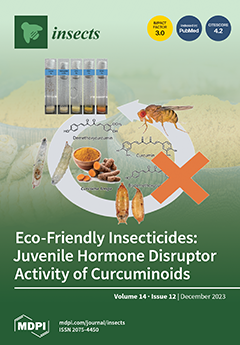Quantitative real-time PCR (qRT-PCR) is widely accepted as a precise and convenient method for quantitatively analyzing the expression of functional genes. The data normalization strongly depends upon stable reference genes. The bean bug,
Riptortus pedestris (Hemiptera: Alydidae), is a significant pest of leguminous crops and broadly distributed across Southeast Asia. In this study, a total of 16 candidate reference genes (
RPL32,
RPS23,
SDHA,
UBQ,
UCCR,
GST,
TATA−
box,
HSP70,
GAPDH,
RPL7A,
SOD,
RPS3,
Actin, α−
tubulin,
AK, and
EF1) were carefully chosen in
R. pedestris, and their expression levels were assessed across various conditions, including different developmental stages, diverse tissues, temperature treatments, adult age, molting time, and mating status. Following this, the stability of these reference genes was evaluated using four algorithms (ΔCt, GeNorm, NormFinder, and BestKeeper). Ultimately, the comprehensive rankings were determined using the online tool RefFinder. Our results demonstrate that the reference gene for qRT-PCR analysis in
R. pedestris is contingent upon the specific experimental conditions.
RPL7A and
EF1 are optimal reference genes for developmental stages. Furthermore, α−
tubulin and
EF1 exhibit the most stable expression across various adult tissues.
RPL32 and
RPL7A exhibit the most stable expression for adult age. For nymph age,
RPL32 and
SOD display the most stable expression. For temperature conditions,
RPS23 and
RPL7A were identified as the most suitable for monitoring gene expression. Lastly, we verified the practicability of evaluating expression levels of odorant-binding protein 37 (
RpedOBP37) and cytochrome P450 6a2 (
RpedCYP6) throughout developmental stages, tissues, and temperature conditions. These findings are a significant addition to the qRT-PCR analysis studies on
R. pedestris, serving as a fundamental groundwork for future investigations on stable reference genes in
R. pedestris as well as other organisms.
Full article






